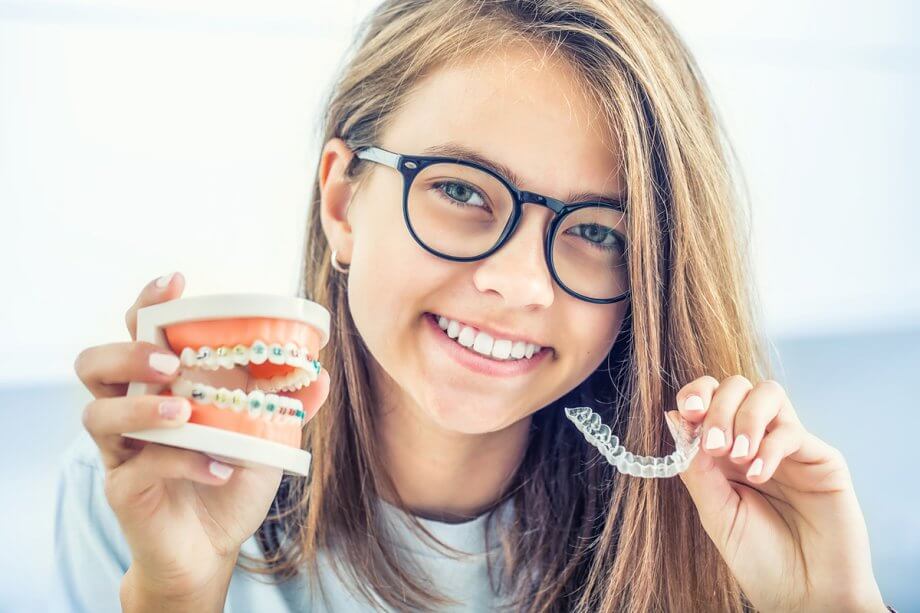Both Invisalign and traditional braces can provide excellent treatment results. However, each method has strengths that could benefit them in certain situations.
This blog will explain the difference between Invisalign and traditional braces and name the situations where each method is better.
Invisalign vs. Traditional Braces
Different Materials
The first distinction between Invisalign and traditional braces is their materials. Invisalign consists of smooth, clear, medical-grade plastic for maximum patient comfort. Braces are usually made from steel and other metal alloys, though clear and tooth-colored ceramic brackets have become more popular today.
How They Work
Invisalign is an ingenious system that creates a graduated series of clear plastic aligners. Each aligner changes slightly, guiding teeth into new positions. They are gentle on your teeth, with only minor pressure and discomfort when changing your aligners.
Braces work by affixing metal brackets to each tooth. Metal bands go around the back molars. A metal archwire connects the bands and brackets, held tight by elastic bands. To move the teeth, the orthodontist adjusts the archwire. Braces adjustments can be uncomfortable.
Comfort
Traditional braces can rub on the tender tissues inside your mouth, creating sore spots. Invisalign is smooth to the touch and creates far less oral irritation.
Discretion
Invisalign blends into your smile. Unless you tell someone you are using Invisalign, it is unlikely they would notice. In contrast, braces stand out. Tooth-colored or clear brackets can help with this problem but are considerably more expensive than metal brackets.
Treatment Time
Invisalign treatment is typically faster than braces. Invisalign may take as little as 12 to 18 months, while braces can take as much as three years.
Cost
Invisalign and metal braces are roughly equivalent in cost, though Invisalign may be slightly more.
Permanence of Results
Both Invisalign and braces show permanent results as long as you faithfully wear your orthodontic retainer in the years after treatment ends. If you do not wear your retainer, you risk losing your investment in your oral health.
Care and Maintenance
Invisalign comes out for eating, drinking, and cleaning. In contrast, braces are not removable and may make it challenging for patients to keep their teeth clean. If patients' oral hygiene suffers, their oral health could worsen and cause tooth decay and gum disease.
When Invisalign Is Your Best Choice
Invisalign works best for older teens and adults with mild to moderate orthodontic issues. Invisalign is an excellent choice for patients with crooked, crossed, or gapped teeth. Invisalign also works on mild to moderate orthodontic bite issues like overbites and underbites.
Anyone with the above conditions who wants a discreet, comfortable treatment method should look into Invisalign.
Situations Where Braces Work Best
Invisalign may not be able to correct severe bite issues or jaw misalignment. Invisalign is also not recommended if you have any missing teeth. Generally, children who need orthodontic treatment also require braces.
People who grind their teeth at night may also need to choose braces. People with bruxism may damage their aligners while they sleep.
Choosing Braces or Invisalign
Both traditional braces and Invisalign are valuable, but Invisalign presents many significant advantages. Children, patients with certain oral health conditions, and those needing extensive correction may do best with braces, but most adult and older teen patients can receive excellent care with Invisalign. Ultimately, the decision is between you and your dental practitioner.
Frequently Asked Questions About Invisalign
Do you need to wear Invisalign while you sleep?
You must leave your aligners in for at least 22 hours daily, including during sleep. You may see delayed results if you fail to wear your aligners for the prescribed time. Fortunately, it does not take long to become accustomed to wearing Invisalign at night.
Do I need to have impressions to get Invisalign?
The Invisalign process is mostly digital. The dentist will take 3-D scans of your teeth using the iTero intraoral scanner. The dentist then uses this data to plan and create a series of aligners to move your teeth into the best position.
Call Manhattan Dental Spa
If you need help deciding whether Invisalign or standard braces could be right for you, please call our Murray Hill, NYC, office at 212-683-2530. We can schedule a consultation where we evaluate your oral health and let you know whether we recommend Invisalign or traditional braces.


